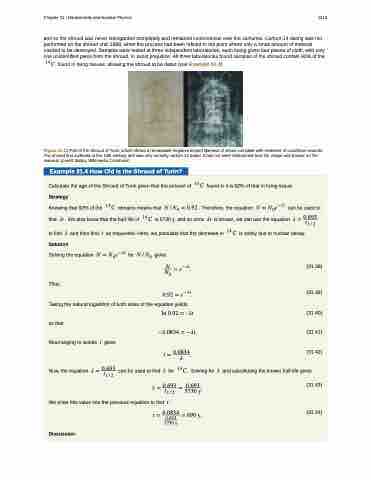Page 1425 - College Physics For AP Courses
P. 1425
Chapter 31 | Radioactivity and Nuclear Physics 1413
and so the shroud was never disregarded completely and remained controversial over the centuries. Carbon-14 dating was not performed on the shroud until 1988, when the process had been refined to the point where only a small amount of material needed to be destroyed. Samples were tested at three independent laboratories, each being given four pieces of cloth, with only one unidentified piece from the shroud, to avoid prejudice. All three laboratories found samples of the shroud contain 92% of the
�� � found in living tissues, allowing the shroud to be dated (see Example 31.4).
Figure 31.22 Part of the Shroud of Turin, which shows a remarkable negative imprint likeness of Jesus complete with evidence of crucifixion wounds. The shroud first surfaced in the 14th century and was only recently carbon-14 dated. It has not been determined how the image was placed on the material. (credit: Butko, Wikimedia Commons)
Example 31.4 How Old Is the Shroud of Turin?
Calculate the age of the Shroud of Turin given that the amount of �� � found in it is 92% of that in living tissue.
Strategy
Knowing that 92% of the �� � remains means that � � �� � ���� . Therefore, the equation � � ������ can be used to
find �� . We also know that the half-life of �� � is 5730 y, and so once �� is known, we can use the equation � � ����� ����
to find � and then find � as requested. Here, we postulate that the decrease in �� � is solely due to nuclear decay. Solution
Solving the equation � � ������ for � � �� gives
�� � � � � � � �
so that
Rearranging to isolate � gives
(31.38)
(31.39)
(31.40) (31.41)
Thus,
Taking the natural logarithm of both sides of the equation yields
Discussion
���� � ����� �� ���� � ��� ������� � ����
� � ������� �
(31.42) Now, the equation � � ����� can be used to find � for �� � . Solving for � and substituting the known half-life gives
����
We enter this value into the previous equation to find � :
� � ����� � ����� � �� � � ���� �
(31.43)
(31.44)
� � ������ � ��� �� �����
���� �


